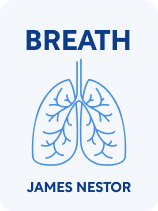

This article is an excerpt from the Shortform book guide to "Breath" by James Nestor. Shortform has the world's best summaries and analyses of books you should be reading.
Like this article? Sign up for a free trial here.
How does controlled breathing help you tap into your body’s latent capabilities? What are some things you can accomplish with controlled breathing?
From Tibetan monks to athletes, there are those who have found ways to use controlled breathing to alter mental states and perform seemingly miraculous feats. Among other things, controlled breathwork techniques can control body temperature, regulate the nervous system, and even alter the heartbeat.
Keep reading to learn about controlled breathing practices.
Controlled Breathing
Breathing is the one bodily function in which our conscious and unconscious systems overlap. Just as your heart regulates blood flow, your stomach digests food, and your immune system fights off infection, your respiratory system needs no conscious control. However, unlike our body’s other autonomic systems, we can purposefully alter our breath. The respiratory system is an opening through which we can consciously influence other autonomic functions. In computer terms, the lungs provide an exploit that we can use to control parts of our bodies that we wouldn’t otherwise have access to.
| Two Sides of Breathing How breath can be voluntary and involuntary isn’t fully understood. There appear to be separate neural pathways that regulate breathing, but where they connect in the brain is uncertain. What’s clear is that there isn’t one “pacemaker” signal, as there is for the heart, though doctors have developed artificial pacemakers for the diaphragm. However, the lungs are regulated by complex biofeedback systems that begin long before we take our first breath. It’s possible that the connection between breathing and voluntary action goes both ways—one study reveals that our “readiness potential” for voluntary behavior is highest when we exhale, suggesting that how and when we breathe has a strong effect on how and when we act. |
Hacking the Nervous System
To understand how this works, Nestor explains how the lungs interact with two different parts of the autonomic nervous system. Different nerves are connected to different parts of the lungs, so by making your breath shallower or deeper, you can deliberately trigger different responses in your body. Nestor describes what the different triggers do, how Tibetan monks developed this practice to survive in the frigid Himalayan heights, and how Dutch athlete Wim Hof uses the same controlled breathwork techniques to perform incredible acts of endurance.
According to Nestor, the autonomic nervous system is actively regulated by breathing. It’s broken into two parts: the parasympathetic nervous system, which triggers rest and relaxation, and the sympathetic nervous system, which gears our bodies up for action. The parasympathetic nervous system is connected to the lower parts of our lungs, which is why slow, deep breaths are calming. Conversely, the sympathetic nervous system is tied to the lungs’ upper regions. Short, rapid breaths that only reach the top of the lungs trigger the sympathetic nerves into action, putting your body into a heightened state of stress. Evolution designed that heightened state for our survival, but the body isn’t meant to stay in it for long.
Nestor writes that a breathing technique known as Tummo (or “inner fire”) was developed in Tibet 1,000 years ago. The practice involves taking a series of breaths into the lower lungs, releasing them with a wavelike motion from the abdomen. After exhaling the final breath, you hold it for as long as you can, then follow that with an enormous inhalation, which you also hold for as long as you can. Nestor repeats that this shouldn’t be attempted without supervision or by anyone with a heart condition.
Tummo activates the sympathetic nervous system and allows a practitioner to remain in that state for extended periods of time. Doing so keeps the body warm, allowing Buddhist monks to weather the extremes of high-altitude cold. Because this technique goes against the body’s natural cycles, though, it can be dangerous and its use was restricted to those who had undergone rigorous training.
Slowly this technique has made it to the outside world. Some soldiers, athletes, and martial artists have used versions of it to prime their bodies for periods of extended exertion. Tummo found its ultimate modern expression in the Dutch athlete and motivational speaker Wim Hof, who has demonstrated its power to ward off frostbite, exhaustion, heatstroke, and even infection. Hof has touted his techniques as beneficial, but Nestor points out that to date, no one knows the long-term effects of activating the sympathetic nervous system for long periods.
Resetting Your Fear Response
While bringing air into different parts of your lungs can trigger different responses in your body, you can also affect unconscious responses by exposing yourself to excess carbon dioxide. In particular, the brain’s chemoreceptors, which act as a fear alarm system for the body, can be trained to have a higher carbon dioxide tolerance. Nestor describes how our chemoreceptors work, the benefits of pushing their limits, and how carbon dioxide therapy has been used to treat a myriad of problems.
The primary function of the chemoreceptors found in the central brainstem is to monitor the amount of carbon dioxide in the blood, telling our lungs when to breathe. If they sense that our carbon dioxide levels are too high, they activate a panic response completely independent of the one in our amygdala. It’s the fear of suffocation or drowning, and it can override any other conscious response. For those with sleep apnea, it’s what wakes you up at all hours of the night. The chemoreceptor response can also be tickled throughout the day if prolonged distraction results in shallow breathing (a condition Nestor describes as “email apnea”).
Nestor suggests that if your chemoreceptors can be trained to tolerate higher levels of carbon dioxide, it opens up a range of possibilities. Flexible chemoreceptors let people adapt to high altitudes or dive to the depths of the ocean. Since carbon dioxide in the body promotes oxygen delivery to organs, trained chemoreceptors can extend the usefulness of every single breath. Furthermore, because chemoreceptors are closely tied to our primal fear response, widening their tolerance range can be useful in treating anxiety and other neurological conditions.
Carbon dioxide therapy is a technique developed by physicians in the early 20th century to reset oversensitive chemoreceptors by raising the body’s carbon dioxide levels. Patients were made to breathe a mixture of 70% oxygen and 30% carbon dioxide, which initially provokes a feeling of suffocation even though the body is being supplied with more than enough oxygen to survive. Repeated exposure was found to alleviate symptoms of anxiety and even wake patients out of catatonic states. Nestor writes that by the 1950s, doctors switched to medication as their primary form of treatment, though research on carbon dioxide therapy resumed in the 1980s.
The Breath of Life
As scientists and physicians work to better understand the ways that breath regulates our body’s functions, practitioners of several ancient traditions have used breath to master the body for thousands of years. In many cultures, breath is believed to be the energy of life, an energy that can be manipulated to spectacular effect. Nestor briefly outlines the nature of these beliefs and cites the example of Swami Rama, whose amazing, breath-induced control of his body was documented by scientists in a 1970 study.
Sages and healers in India and China identified breath—known as prana to students of yoga—as the energy of life as many as 3,000 years ago. The practices of yoga go back further still, to images passed down from the Indus Valley civilization dating 5,000 years before the present, although yoga’s early forms were not as they are today. Nestor says that while modern yoga emphasizes movement and poses, ancient yoga focused on sitting and breathing.
In these practices, breath is the process by which prana—the life force—is built up and distributed throughout the body. Yogic masters are reportedly able to move and manipulate the energy of prana inside them. Science has never established prana’s existence, though scientists at the Menninger Clinic made intriguing observations in 1970. They subjected a yoga teacher named Swami Rama to a battery of tests, during which he was able to consciously alter his heartbeat, body temperature, and even his brain waves, all through the power of controlling his breath.
No solid theory has been able to explain how Swami Rama was able to perform these feats, though Nestor suggests that the most plausible guess has to do with how oxygen affects the flow of electrons through the body. Many mysteries remain about how breath drives the body, and much research remains to be done. However, Nestor strongly asserts that how we breathe dictates how well we live and deserves as much attention as any other vital part of our lives.

———End of Preview———
Like what you just read? Read the rest of the world's best book summary and analysis of James Nestor's "Breath" at Shortform.
Here's what you'll find in our full Breath summary:
- Why you're probably breathing wrong
- The benefits of learning how to breathe properly
- The potentially dangerous side effects of mouthbreathing






